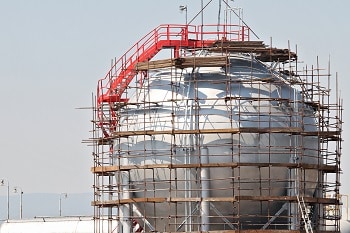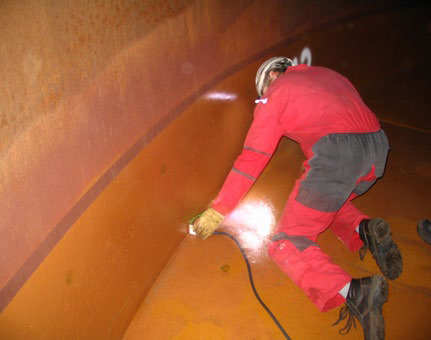The Relevance of Expert Tank Welding Inspection Services

Comprehending the Relevance of Rigorous Container Welding Evaluation Processes in Averting Failures and Enhancing Life Expectancy
In the world of commercial procedures, the significance of strenuous container welding assessment processes can not be overemphasized. By applying different assessment approaches, organizations can spot defects early, therefore preventing pricey repercussions and expanding the life of their storage containers.
Importance of Welding Examinations
Recognizing the critical duty of welding examinations in preserving structural stability, these procedures ensure that welds satisfy established requirements and requirements - Tank Welding Inspection. Efficient welding examinations are extremely important in the building and construction and maintenance of tanks, as they straight impact the toughness and safety and security of the frameworks. By determining potential deficiencies, such as inappropriate techniques or material flaws, evaluations mitigate the threat of devastating failures
Welding assessments incorporate various techniques, consisting of visual exams, non-destructive testing (NDT), and evaluations of welding treatments. Each technique offers to validate the top quality and conformity of welds with market laws, therefore protecting both personnel and ecological rate of interests. Furthermore, routine inspections cultivate a culture of responsibility and quality within the workforce, guaranteeing that all group participants adhere to finest techniques.
Furthermore, these evaluations add to the total lifecycle management of storage tanks by recognizing wear or destruction early at the same time. By addressing these problems proactively, companies can expand the operational life expectancy of their assets, ultimately bring about cost savings and improved integrity. In recap, the relevance of welding assessments can not be overstated; they are essential for making certain safety and security, longevity, and conformity in container construction and maintenance.
Usual Root Causes Of Container Failures
Comprehending the common sources of tank failures is necessary for avoiding devastating cases and guaranteeing the long life of storage space systems. One widespread reason for container failure is rust, which can dramatically compromise the structural stability of containers gradually. Environmental variables, such as direct exposure to wetness, chemicals, and temperature level fluctuations, can increase this procedure.
One more vital element is incorrect welding strategies, which may lead to issues like fractures or incomplete joints. These issues can endanger the tank's stamina and result in leaks or tears. Furthermore, poor upkeep practices can result in undiscovered deterioration, inevitably raising the risk of failing.
Design defects, including insufficient thickness or poor material choice, can also add to tank susceptabilities. Additionally, functional elements, such as overfilling or direct exposure to severe stress, can stress the container beyond its intended limits.
Trick Inspection Methods
Efficient evaluation strategies play a vital role in reducing the risks linked with tank failures. A comprehensive method to storage tank welding examination involves a number of essential methods, each designed to recognize possible issues and ensure architectural stability.
Aesthetic examination stays the first line of protection, permitting assessors to recognize surface area anomalies such as fractures, deterioration, or imbalance. This strategy is often supplemented by non-destructive testing (NDT) approaches, you can check here which are important for analyzing weld top quality without endangering the storage tank's honesty.

Furthermore, magnetic particle screening (MPT) and color penetrant screening (DPT) work for identifying surface area issues in ferromagnetic products and non-porous surfaces, specifically. Each strategy has its strengths and limitations; for that reason, a combination of methods is often employed to accomplish detailed examination outcomes.
Advantages of Rigorous Inspections
While the immediate prices of rigorous examinations might appear difficult, the lasting benefits significantly outweigh these initial financial investments. Applying thorough examination refines not just boosts the honesty and security of storage tank frameworks but also reduces the threat of tragic failures that can cause considerable monetary losses and environmental harm.
Rigorous examinations assist recognize potential issues early in the welding procedure, enabling for timely corrective activities that prevent expensive repair work or substitutes down the line. This aggressive method fosters a culture of quality control, where adherence to ideal techniques comes to be ingrained in operational procedures. Regular evaluations add to boosted possession durability, as they make certain that storage tanks continue to be in optimum condition throughout their lifespan.
Furthermore, the paperwork generated from these evaluations functions as a beneficial resource for maintenance preparation and efficiency analyses. This data-driven strategy can additionally boost operational efficiency, resulting in reduced downtime and enhanced performance. Ultimately, rigorous examinations not only guard the architectural honesty of containers yet additionally supply considerable financial advantages, strengthening the concept that purchasing high quality assurance is a sensible choice for any kind of company associated with tank procedures.
Governing Criteria and Compliance
Governing top article criteria and conformity are essential parts of container welding inspection procedures, as they establish the framework for guaranteeing security and top quality in operations. Conformity with these requirements not just alleviates dangers but additionally improves the total integrity of welded structures. Various companies, including the American Society of Mechanical Engineers (ASME) and the American Petroleum Institute (API), provide standards that determine appropriate practices for welding, evaluation, and screening.
These requirements mandate using qualified personnel, the implementation use this link of rigorous evaluation protocols, and adherence to specific welding procedures. By aligning with regulatory needs, companies can make sure that their tanks fulfill the required safety and security and efficiency standards, consequently minimizing the possibility of disastrous failings that can lead to substantial economic losses and ecological damages.

In addition, governing compliance cultivates a society of liability and continual improvement within the welding and construction fields (Tank Welding Inspection). Regular audits and inspections guarantee that techniques stay lined up with developing criteria, thereby promoting lasting integrity and functional effectiveness. Inevitably, adherence to regulative requirements not just shields possessions but additionally improves the lifespan of bonded tanks, ensuring they serve their desired objective successfully over time
Verdict
In verdict, extensive tank welding assessment processes play a crucial role in protecting against failings and prolonging the life expectancy of storage space structures. By determining potential shortages with various evaluation methods, companies can mitigate dangers connected with storage tank stability.